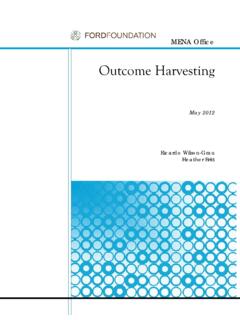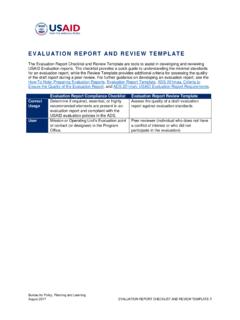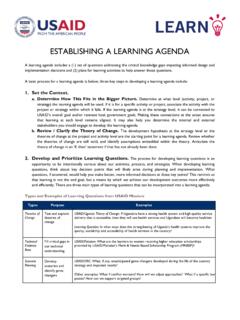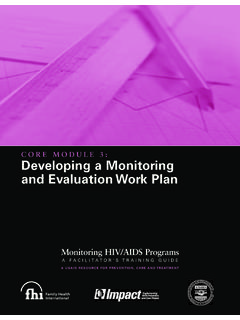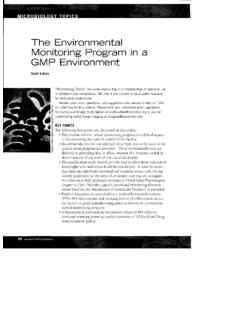Transcription of Program Cycle: How-To Note: Project Monitoring, …
1 Program CYCLE. How-To Note: Project monitoring , Evaluation, &. Learning (MEL) plan Introduction This resource describes how to This How-To Note supplements ADS . It provides an overview of what is prepare and required in a Project monitoring , Evaluation, and Learning (MEL) plan , and outlines maintain a practical steps for developing, maintaining, and using a Project MEL plan . The primary Project monitoring , audience includes Project Managers, the Project Design Team, Project Team, Activity Evaluation, and Managers operating under the Project , Technical Office staff and directors, Program Learning plan .
2 Officers, and any M&E Specialist or Learning Advisor supporting the Project . Background The Project MEL plan is developed during Project design. It describes how the Project Team plans to collect, organize, analyze, and apply learning gained from monitoring and evaluation data and other sources. Although approved as a section of the Project Appraisal Document (PAD), the Project How-To notes MEL plan should be revisited and updated on a regular basis. In the initial development provide guidelines and practical advice of the Project MEL plan , the Team should set up guide-posts with the intention to to USAID staff and finalize or revise it as implementation progresses, activities are awarded, and new partners related to information is learned.
3 The Program Cycle. This note was Content of the Project MEL plan produced by the The Project MEL plan contains at least three distinct, yet interrelated sections: (1). Bureau for Policy, monitoring , (2) evaluation, and (3) learning. Each section should be concise. A guiding Planning and Learning (PPL). principle to the development of the plan is to include those monitoring , evaluation, and learning processes that will produce information to be used at periodic Project reviews to inform decision-making to adaptively manage the Project or to inform lessons for future projects.
4 There is no required or standard format for a Project MEL plan , though some USAID. Missions have created their own template. Project Teams may have sections or components they would like included beyond the required sections of monitoring , evaluation, and learning. PMPs, Project MEL Plans, and Activity MEL Plans The following sections outline requirements and Performance Management plan (PMP) is recommendations for content to be included in the developed by a Mission following CDCS approval Project MEL plan . to monitor, evaluate, and learn from the strategy. INTRODUCTION (Recommended) Project MEL plan is developed by a USAID team during Project design to monitor, evaluate, and learn An introduction enables the Project MEL plan to act as from a USAID Project .
5 A standalone management tool for the Project Team. This section introduces the Project MEL plan , outlines Activity MEL plan is typically developed by an the structure of the plan , and describes its intended implementing partner following award to monitor, evaluate, and learn from a USAID activity. use. The Project Team may also decide to include the Project logic model with explanation of the key Each plan serves a distinct management purpose, monitoring , evaluation, or learning efforts discussed in but they are related and should be congruent, with the plan , and how they relate to each other.
6 For some information appearing in multiple plans. For example, results and assumptions highlighted in the instance, a performance indicator may have logic model might be paired with the indicators relevance for, and appear in, all three plans; an selected to monitor those results and assumptions. evaluation planned during Project design may Likewise, the introduction may show how key learning appear in both a Project MEL plan and the PMP; or learning questions that emerge during CDCS. and evaluation questions relate to specific aspects of development may appear in all three plans.
7 The logic model. Information should not simply be duplicated in all monitoring SECTION (Required) plans, but should only be included as necessary. For example, an indicator that is useful for a Project and The monitoring section describes how the Project will an activity does not need to appear in a PMP. monitor both performance and context. Performance monitoring tracks progress toward planned results defined in the logic model. Context monitoring tracks the assumptions or risks defined in the logic model. In other words, it monitors the conditions beyond the Project 's control that may affect implementation.
8 Performance monitoring Indicators The monitoring section must include at least one performance indicator to monitor progress toward the achievement of the Project Purpose, the key result to be achieved by the Project . If the Project Purpose is aligned to a result in the Country Development Cooperation Strategy (CDCS) Results Framework, such as an Intermediate Result (IR), for example, then the same indicator(s) should monitor the achievement of both the Project Purpose and the Results Framework result to which it is aligned. During the Project design process, indicators that were identified during CDCS development are often revised.
9 The Project MEL plan includes the current indicator(s), and the PMP is revised to include the updated indicator(s). The monitoring section also includes other key Project performance indicators that are necessary to monitor progress toward achievement Helpful Hint of expected Project outcomes below the Project Purpose. ADS 201 For a typical Project , the CDCS. sub-IRs are likely to be significant states that such key Project performance indicators should measure and relevant outcomes to monitor outcomes that are (1) relevant , related to the Project 's logic for Project management.
10 Model and (2) significant , an important outcome in the chain of results that lead to the Project Purpose. VERSION 2 / MARCH 2017 PAGE 2. ADS 201 provides considerable discretion to the Project Team to decide which results should be monitored by performance indicators and how many performance indicators to include in the Project MEL plan . Not every expected result described in the Project design or depicted in a Project logic model requires an associated performance indicator. Nor should every activity-level indicator from MEL Plans of activities under the Project be included in the Project MEL plan .
